Chongqing Vanke Luhai International Center
-
Location
Chongqing
-
Client
Vanke Group
-
Design
KPF
-
Building Area
520420㎡
-
Building Height
458.2m
-
Project Status
2020 completed
Forcitis has participated as a façade consultant in 30% of new urban landmarks. Chongqing Vanke Luhai International Center, as a new landmark building along the Jialing River, is one of them.
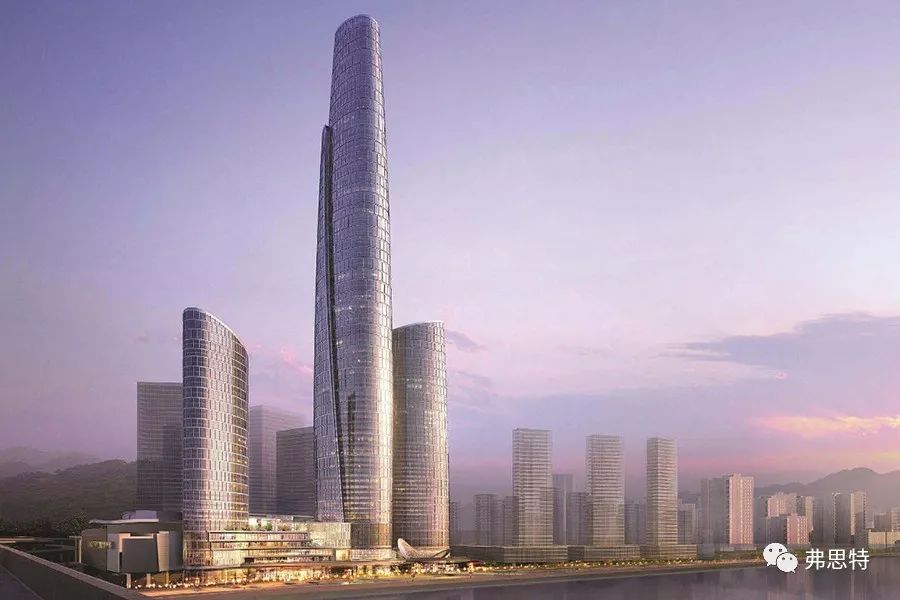
/ Project Information: A leaf sailboat, standing on the bank of Jialing River /
Chongqing Vanke Luhai International Center is located in Hualongqiao area of the main city of Chongqing, adjacent to Jialing River in the north, Huasheng Road in the south, Jiahua Bridge in the east and Chongqing Tiandi in the west. The residential area consists of TP1 tower, TP2 tower, TP3 tower and commercial podium. Among them, the building height of TP1 tower is 255.8m, the building height of TP2 tower is 458m, the building height of TP3 tower is 181m, and the commercial podium has 7 floors above ground, which connects TP2 and TP3 towers as a whole.
The scope of Forcitis's design is TP2 tower, TP3 tower and commercial podium. This project is the first large-scale commercial+office+hotel+apartment complex invested and constructed by Vanke. TP2 tower is the highest building height of Vanke so far, and it is also the second tallest building in Chongqing.

Chongqing, surrounded by mountains, is at the confluence of the Yangtze and Jialing Rivers. Located on the Jialing River, Chongqing Vanke Luhai International Center is designed by KPF Architects of the U.S. The building shape is inspired by the sailboat that used to sail across the Yangtze River and the Jialing River, and the three towers and commercial podiums are staggered to form the shape of the sailboat with sails. The lines of the building are light and elegant, and after the completion of the project, it will look like a sailboat standing by the Jialing River.
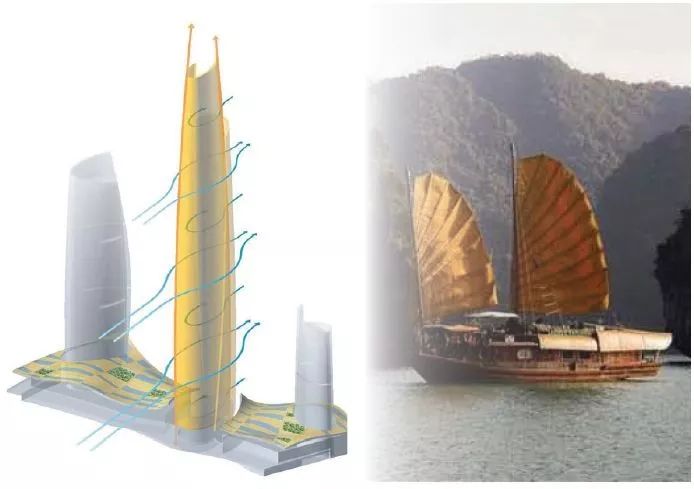
Chongqing is a national historical and cultural city. In 1189, Emperor Guangzong Zhao Dun of Song Dynasty, who was crowned as King Gong and then Emperor, boasted of his "double happiness", from which Chongqing got its name, and the architect's inspiration for the façade design of the tower also comes from "double happiness". The texture of the tower's façade resembles the Chinese character Xi, a symbol that displays a strong graphic theme in the brightly lit nightscape of Chongqing, in the misty white weather, under the sunlight, and in various situations in Chongqing. The layers and variations of geometrical patterns also emphasize the tower's modern and futuristic lines and shapes.
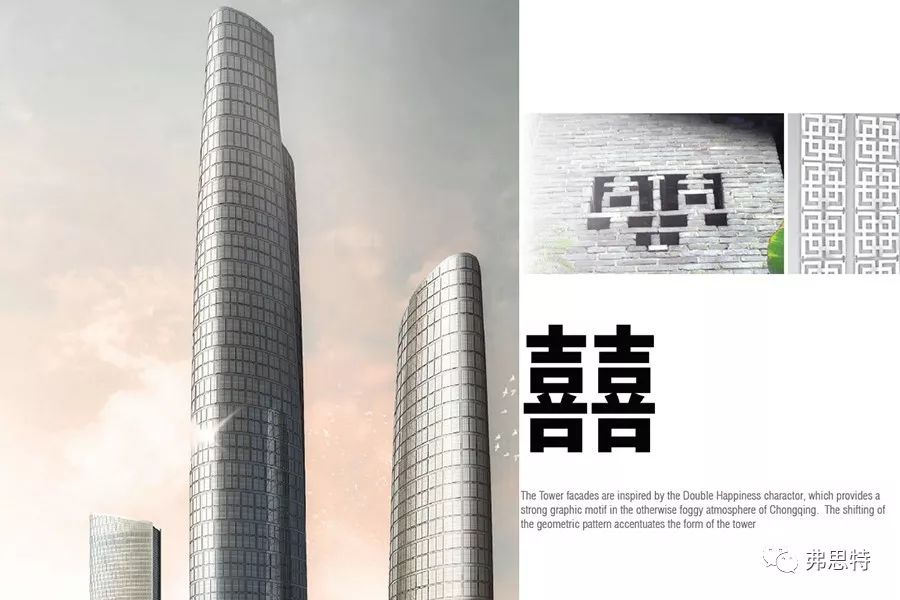
/ Facade form analysis /
TP2 tower
The TP2 tower is curved in plan and elevation. The plan consists of two parts, the curved section and the capping wall. The façade is segmented from the 25th floor, with the area above the 25th floor sloping inwards and the area below the 25th floor sloping outwards. The curtain wall design is in the form of straight slabs fitting curved surfaces in order to reach the realization of the final architectural effect.
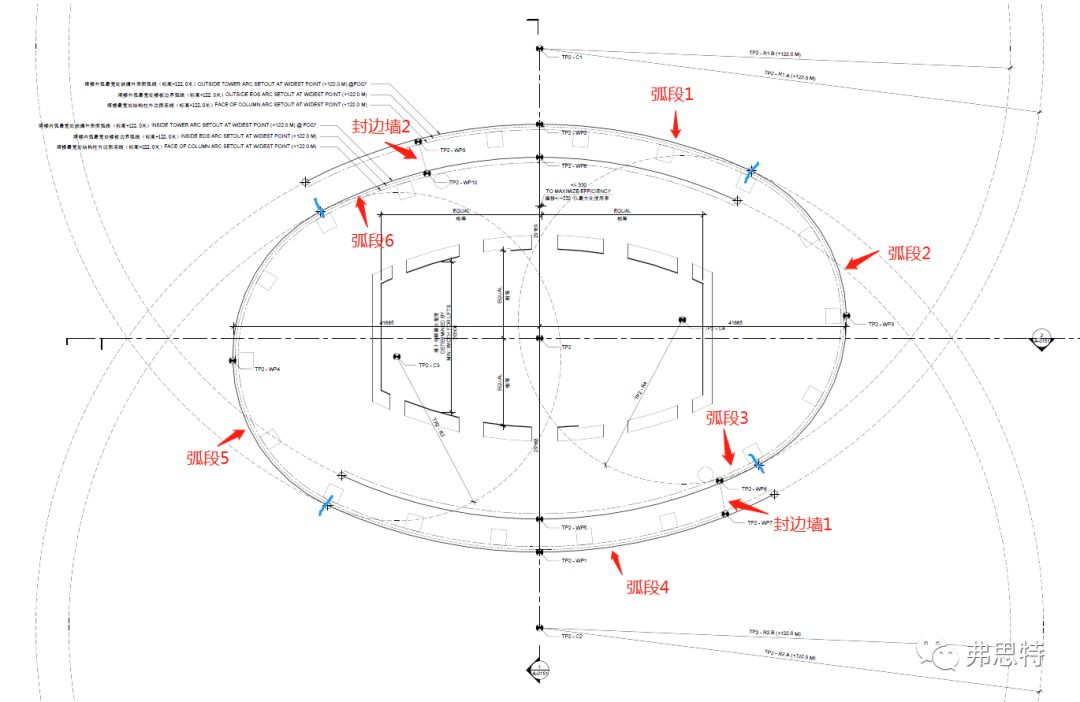

According to the analysis of the building model, the unit slabs in the curved face area of the TP2 tower are all straight. In the sealing wall area, there are four points of non-coplanarity in the local location of the unit plate, and the maximum warping point is about 10mm. For the location of the four points of non-coplanar, the straight plate block cold bending processing is used to realize the hyperbolic fitting effect.
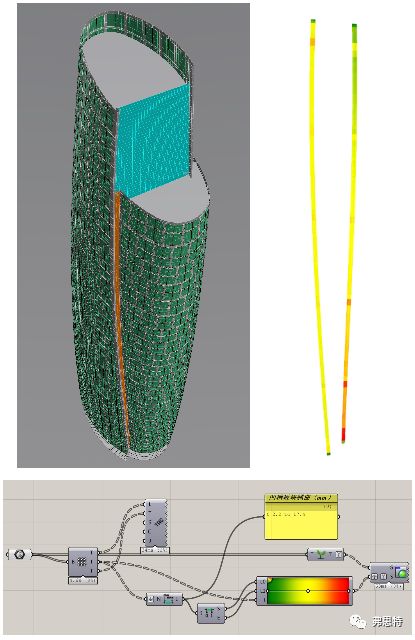
TP3 tower
The TP3 tower's flat building envelope consists of curved and straight surfaces, with no angular changes in the façade. straight slabs are used in the TP3 tower to achieve the final building façade effect.

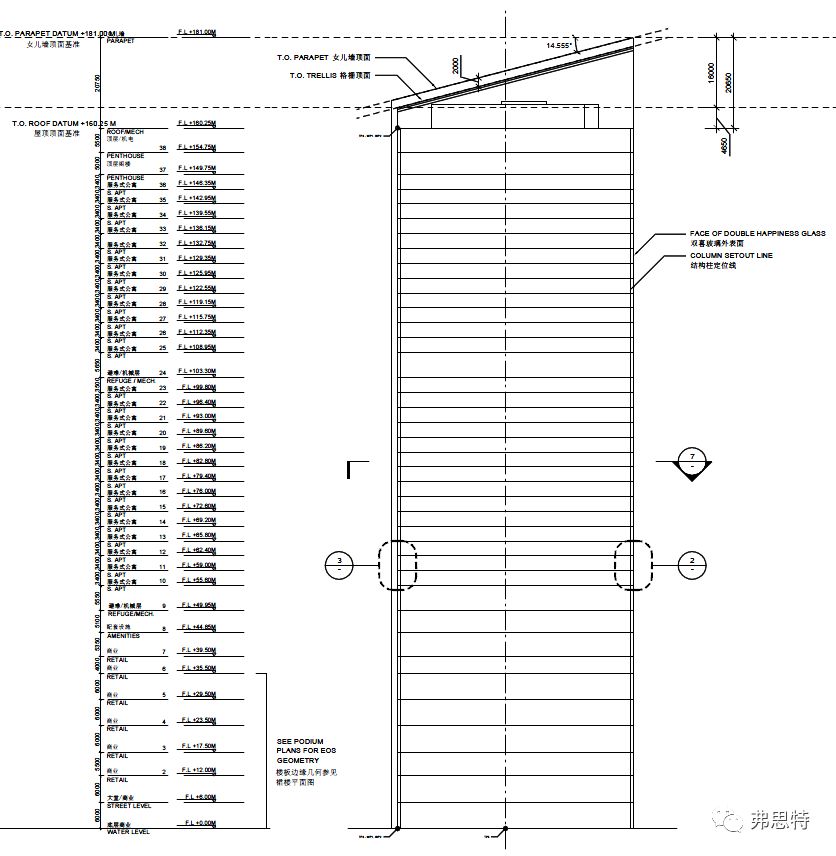
/ System deepening design /
TP2 tower
The main curtain wall form on the façade of the tower is the Double Happiness standard unit type glass curtain wall, which consists of 6 horizontal compartments and 4 vertical floors, totaling 24 unit panels. There are two line elements set in the middle of the Double Happiness area, which play the role of connecting the Double Happiness pattern. Each complete Double Happiness pattern has a mis-seam in the horizontal compartment at its upper and lower intersections (every four floors).

Double Happiness standard modular curtain wall is mainly distributed in the area of arc segments in plan. According to the plan, there are 3 different diameters in the curved contour of the building: where arc segment 1 is the same as arc segment 4, arc segment 2 is the same as arc segment 5, and arc segment 3 is the same as arc segment 6.
Due to the consistency of the compartmentalization of each floor, there are actually 3 angular relationships between the straight panels for surface fitting. Among them, arc section 2 (arc section 5) regional plate angle (176 °) relative to arc section 1 (arc section 4) (178.9 °), arc section 3 (arc section 6) regional angle angle difference (179 °), arc section 1 (arc section 4) and arc section 3 (arc section 6) regional plate angle angle is basically similar, after analysis, in the design of the Double Happiness unit plate male and female columns only 2 sets of profiles can be adapted to this arc section Angle changes in the region.


Geometric planes of building contours

Plane Angle Distribution Schematic

standard cross-section
Tower building façade contour vertical existence of angular changes, the relationship between the interior transom and the glass panel according to the requirements of the interior effect of the different existence of two options:
Option 1: the transom is perpendicular to the glass panel, and the top and bottom surfaces of the transom are beveled;
Option 2, the transom is not perpendicular to the glass panel, and the top and bottom surfaces of the transom are kept horizontal.
Option 1 in the design does not need to consider the transom to follow the changes in the building elevation profile, the transom construction design is relatively simple, usually consider a set of profiles can meet; Option 2 in the design of the transom need to consider the changes in the building elevation profile, the use of split-type transom design or will be each layer of the elevation profile and the horizontal angle of statistics, analysis, to determine the design of a variety of cross-sectional profiles molds in order to meet the indoor effect needs.
According to many communications and comparisons with the architect, this project adopts the form of Option 1.
The beam design not only needs to consider the requirements of the building interior effect, but also the functional requirements:
a, unit curtain wall watertightness, airtightness design: this project is a super-high-rise project, combined with the local climate characteristics, considering the building outdoor wind pressure changes, and relative to the general height of the building external environment is more severe. In the system design process, the unit curtain wall male and female columns and upper and lower beams of the watertight line position of the plug fin structure optimization, to avoid the unit plate in the processing engineering, the lower end of the male column plug fins and adhesive strips were destroyed, and to ensure that the adjacent unit plate in the field after the completion of the installation, the adhesive strips can be effective in the plug fins on the formation of the intersection of the circle sealing. At the same time, in order to further reduce the possibility of rainwater entering the sink of the unit-type upper beam, and to ensure the effective discharge of a small amount of rainwater in the sink, the project adopts a hidden drainage design.
b. Influence of vertical deformation of structure, deformation of temperature difference, deformation of self-weight, processing, assembling and installation errors of slabs and other unfavorable factors on the displacement space of slab insertion.
c, the influence of the angle between the profile of the building façade and the horizontal line of each floor on the drainage profile of the upper beam: according to the analysis of the profile of the building façade, the profile of the building tilts inward since 25F or above, and the area below the 25th floor tilts to the outdoor. The change interval of inward tilt angle is 90°~86.5°, and the change interval of outward tilt angle is 90°~91.1°. When tilted outward, the drainage of the upper crossbeam of the unit slab is in a favorable state, so this project only considers the effect of the inward tilt angle on the drainage slope of the upper crossbeam of the unit when tilted inward.
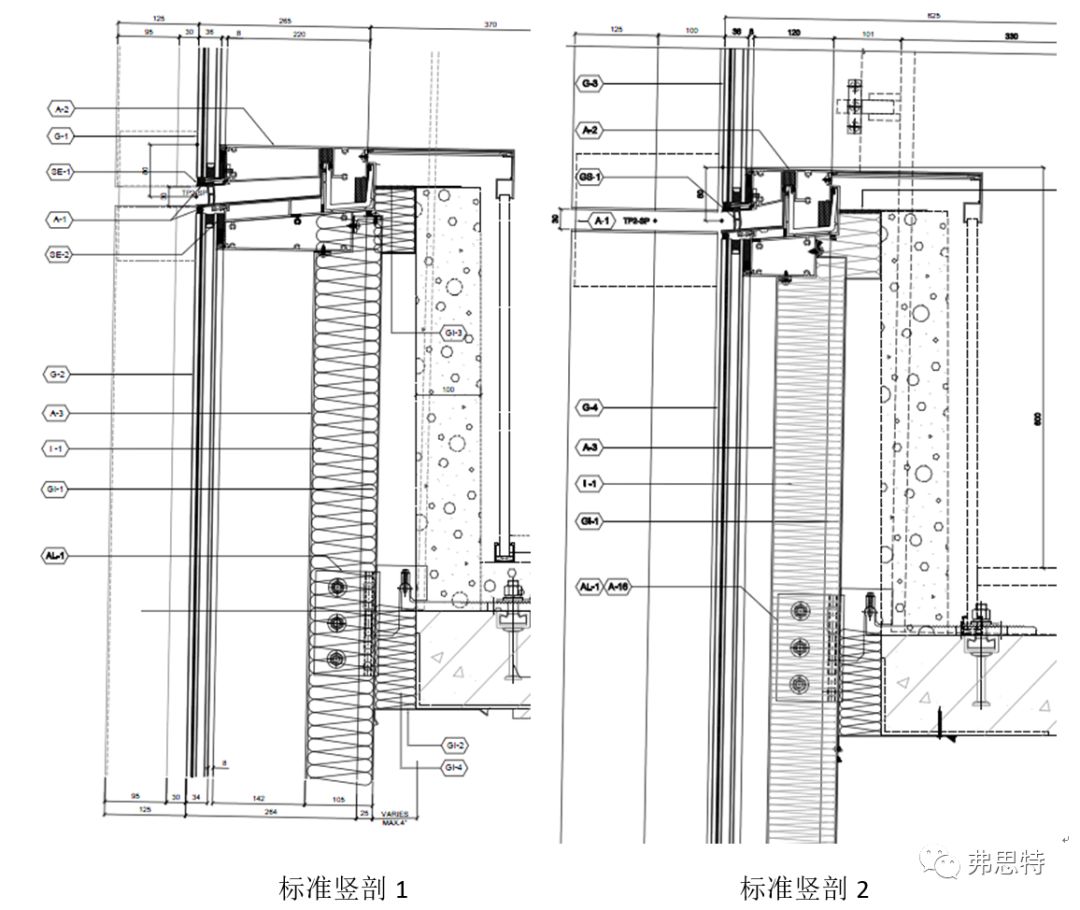
At the intersection of each of the four levels of the Double Happiness pattern, there is a misalignment of the upper and lower transverse compartments. In this case, the upper and lower beams at the cell block junction are receding and there is a situation where one block spans over two blocks at the same time. By analyzing the variation of the radius of the arc profile in the plane and combining it with the profile of the building elevation, it can be seen that the area with the largest recession is located in the area of the crown of the building tower in the elevation, and in the part of arc section 2 and arc section 5 in the plane.
In this project, the maximum in/out value of the upper and lower beams before and after the conversion level unit plate is 26mm (Fig. 1), and the upper beams of the lower unit plate of the conversion level are considered to be of split design (Fig. 2), which consists of separated sinks and separated beams. Separate sinks can be arranged according to the projected position of the lower beam of the upper plate in the conversion area to the corresponding position in the sink of the separate upper beam (Figure 1), and the width of the sink of the separate upper beam is the width of the separate sink material + the maximum difference between in and out, so as to facilitate the flexible installation of the separate sinks in the space of this area.
Because the separate sink for independent components, greatly improving its processing flexibility, and in the factory and separate the upper beam assembled together, its processing quality and waterproof measures can also be effectively guaranteed. The unit plates in this area can be installed on site in the same way as those in the standard area, which ensures the installation efficiency and construction quality on site.

Figure 1
For the location of the edge wall four points are not coplanar plate, the project considers the cold bending design, the keel of the plate to consider the use of space frame form, the glass panel to consider the use of straight glass in the factory cold bending treatment (as shown in Figure 2). At the same time, in order to prevent the glass panel cold bending treatment leads to stress concentration, thereby increasing the rate of glass explosion, in the design process, the use of finite element force calculation software, consider the most unfavorable working conditions on the cold bending of the glass after the analysis of the force situation, to ensure that the program from the design of the implementability and safety.


Figure 2
TP3 tower
According to analyzing the outline of the outer skin of the planar building, it can be seen that the curtain wall of TP3 tower consists of straight surface curtain wall and curved surface curtain wall, in which the curved surface area, according to the different radius of the arc, there are two cases of male and female columns in the unit plate, so there are a total of three cases of male and female columns in the curtain wall of the unit plate of the TP3 tower.
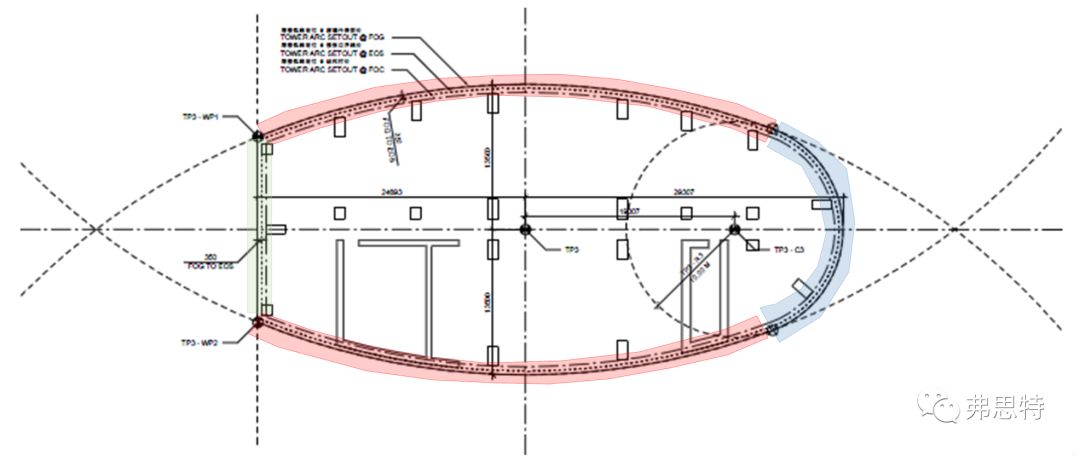
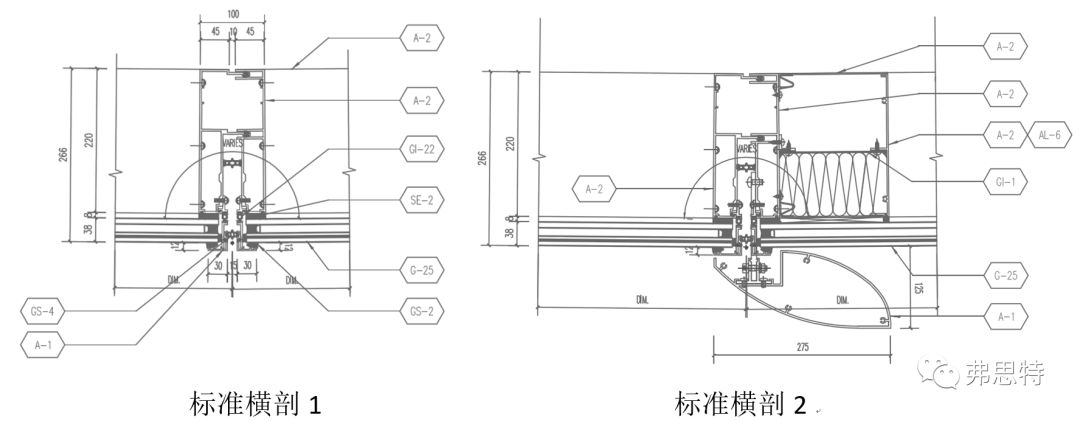
TP3 tower every 2 floors junction position, the inter-storey area panel is metal plate and relative to the glass panel finish surface recedes 80mm. façade vertical decorative strips are set up every interval of 3 horizontal compartments, continuous span 2 floors; every 2 floors junction position, decorative strips are misplaced. The same radius arc section in the arc surface area, the unit plate adopts the same male and female column material. Interlayer panel retreat part of the plate, male and female column material in the interlayer retreat height to consider milling processing.


In the process of system deepening design, we not only consider the design of curtain wall system based on the overall perspective of the project to ensure the appearance effect, meet the performance requirements, and control the cost of the project. At the same time, we have made a lot of optimization suggestions for the project based on the design of the curtain wall, from the perspectives of architectural safety, architectural effect, architectural design, structural design, and other related professions by sorting out the original curtain wall scheme and building related data, which have been adopted. At the same time, a large number of potential risks were avoided at the design stage for the later stages of the project.
A sailboat setting sail, a history of the origin of the name "Chongqing", a new era of architects' ideas, a construction unit praised by all. The friction between city and design, the collision between history and culture and new technology, Chongqing Vanke Luhai International Center was born in such an environment, which contains the historical heritage, but does not lose the elegance of the new era, backed by the history, facing the future. Forcitis is glad to contribute to such a project and hopes that our technology can serve more projects.
-

 Chongqing Vanke Luhai International CenterChongqing Vanke Luhai International Center, High-end commercial building integrating commerce, leisure, hotel and office.
Chongqing Vanke Luhai International CenterChongqing Vanke Luhai International Center, High-end commercial building integrating commerce, leisure, hotel and office. -

 Shenzhen Shimao Shengang International CenterThe architectural lines are smart and elegant, integrating the crystallization of nature, art and science, and integrating the future life picture with the innovation and development of the city.
Shenzhen Shimao Shengang International CenterThe architectural lines are smart and elegant, integrating the crystallization of nature, art and science, and integrating the future life picture with the innovation and development of the city. -

 Jinan Vanke MetropolisA service concept that goes beyond what is thought of to reshape people's imagination for a better city.
Jinan Vanke MetropolisA service concept that goes beyond what is thought of to reshape people's imagination for a better city.







